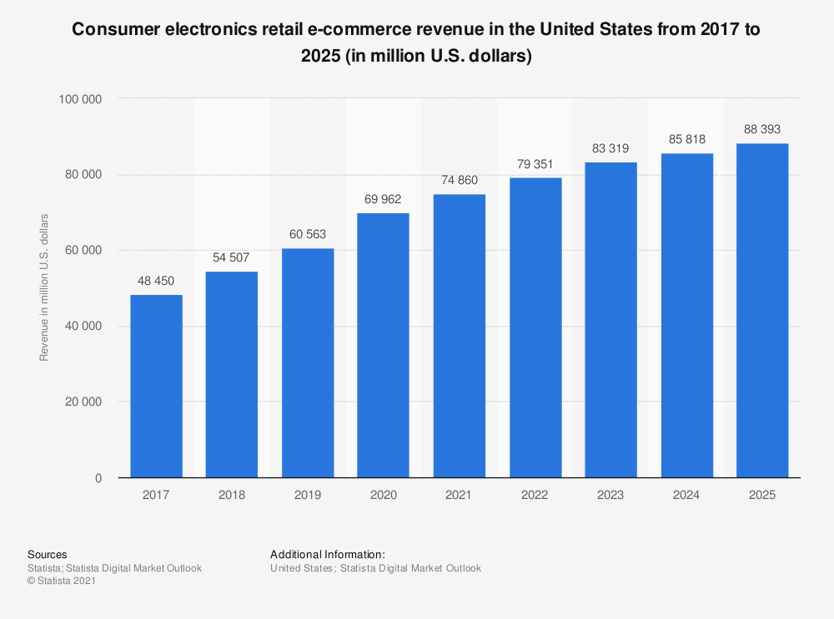[Industry Focus] Fraud Risk Profile for Electronics Retailers
You can generally count on the latest and greatest electronics to come with a significant price tag, whether it’s the new iPhone or a hoverboard. And yet, despite the cost, these in-demand items sell like hotcakes. Unfortunately, these two factors make electronics products a smoking hot target for fraudsters.
Let’s survey the current landscape and identify what retailers can do to protect themselves against the increased fraud risk associated with consumer electronics.
Why Is Electronics Fraud Such a Problem?
Typically, expensive and popular items are more susceptible to fraud, and electronics are certainly both expensive and very popular. While some In the United States alone, consumer electronics retail ecommerce revenue jumped from $60.5 billion in 2019 to $69.9 billion in 2020—and is expected to reach $88.4 billion by 2025. And what about worldwide? Revenues are expected to hit over $2 trillion by 2023. None of this is surprising considering the increasing cost of some consumer electronics: The average price of smartphones in the U.S. rose from $403 in 2016 to $633 in 2021—an eyewatering 57.46% increase in just five years.

This high dollar value is just one reason for the increased fraud risk with electronics products. Other reasons include:
- New technology is always in demand. Fraudsters know they can quickly find a buyer for most new products.
- Handheld electronic devices are easy to ship and store for resale, meaning the carrying cost is relatively low for fraudsters.
- Electronics can generally be resold at a price close to the purchase price – which means more cash for the fraudster.
What Fraud Looks Like for Electronics Retailers
Electronics fraud can take many forms, from friendly fraud to card-not-present (CNP) fraud. As a result, electronics retailers should be mindful of:
- Volume spikes. Electronics retailers can expect an increase in fraud attempts to occur around Black Friday and Cyber Monday and during product launches
- Triangulation schemes. This fraudulent transaction starts by a fraudster buying stolen credit card information. He then lists an item (a computer, for example) for sale on an online marketplace at a reasonable price point. After a consumer purchases it, the fraudster uses the stolen credit card to purchase the advertised item from another retailer and ship it to the purchaser. The fraudster pockets the money from the sale, while the credit card holder, the merchant and the purchaser become fraud victims.
- Counterfeit barcodes. Fraudsters place counterfeit barcodes on high-priced products, artificially lowering the cost. After the thief buys the product in-store at the reduced price, he then resells it online for at or near the market price.
- Stolen identities and accounts. Thieves use stolen identities and take over mobile phone accounts to pose as existing customers who want to purchase new phones through the carrier’s subsidized program. The fraudsters then quickly resell the phones at a profit.

What Recourse Do Electronics Retailers Have?
How can online merchants minimize their fraud risk?
- Monitor activity. Keep an eye on even small changes to online ordering activity.
- Are there increased orders that appear to be initiated within the United States but the IP addresses indicate they’re overseas?
- Are you seeing small orders process, followed quickly by larger orders?
- If so, you might be experiencing a fraud attack.
- Be proactive. You can report fraudulent transactions only when they’ve processed — and by then, it’s too late.
- Instead, identify and flag suspected fraud attempts, such as repeated small transactions, to minimize your losses.
- Once a fraudulent order goes through successfully, online systems tend to recognize the fraudster as legitimate, making future fraud attempts harder to flag and stop.
- Know your inventory’s fraud appeal. Small, lightweight GoPros and iPads will be a bigger target for fraudsters than large, heavy printers and refrigerators.
- Identify shipping scams. Are your business’s packages being rerouted?
- If they are, ask carriers to return packages to you if an in-transit reroute is requested.
- Look for warranty waivers. Fraudsters are unlikely to purchase a warranty on an electronic device they plan to resell.
- Screen every order. Send flagged items to analysts for additional review. But make sure you don't fall into the trap of auto-declining orders—they may not all be fraudulent, creating a false decline. Our 2021 Global Ecommerce Consumer Behavior Analysis revealed that 39% of consumers would flat-out boycott a retailer if their purchase was falsely declined.

Minimizing the Fraud Risk Exposure for Electronics Consumers
In our increasingly digital society, consumer electronics will only become more integrated in our everyday lives, creating incredible growth opportunities for consumer electronics retailers. However, the high desirability of these items comes with an equally high risk of fraud. Retailers need to stay aware of fraud trends and take steps to fight fraud while still providing a great customer experience.
At ClearSale, we’re committed to helping electronics merchants maximize their sales and protect their profits. Contact us today to learn more about our chargeback guarantee and how it can help your business.
 Sarah Elizabeth
Sarah Elizabeth
